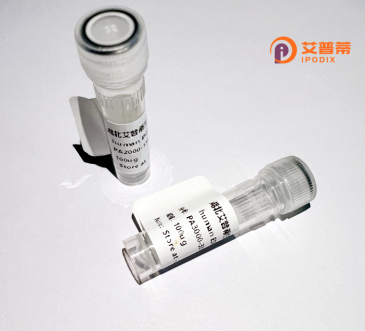
| 纯度 | >90%SDS-PAGE. |
| 种属 | Human |
| 靶点 | ZNFN1A2 |
| Uniprot No | Q9UKS7 |
| 内毒素 | < 0.01EU/μg |
| 表达宿主 | E.coli |
| 表达区间 | 1-500 aa |
| 活性数据 | METEAIDGYITCDNELSPEREHSNMAIDLTSSTPNGQHASPSHMTSTNSVKLEMQSDEECDRKPLSREDEIRGHDEGSSLEEPLIESSEVADNRKVQELQGEGGIRLPNGERPFHCNQCGASFTQKGNLLRHIKLHSGEKPFKCPFCSYACRRRDALTGHLRTHSVGKPHKCNYCGRSYKQRSSLEEHKERCHNYLQNVSMEAAGQVMSHHVPPMEDCKEQEPIMDNNISLVPFERPAVIEKLTGNMGKRKSSTPQKFVGEKLMRFSYPDIHFDMNLTYEKEAELMQSHMMDQAINNAITYLGAEALHPLMQHPPSTIAEVAPVISSAYSQVYHPNRIERPISRETADSHENNMDGPISLIRPKSRPQEREASPSNSCLDSTDSESSHDDHQSYQGHPALNPKRKQSPAYMKEDVKALDTTKAPKGSLKDIYKVFNGEGEQIRAFKCEHCRVLFLDHVMYTIHMGCHGYRDPLECNICGYRSQDRYEFSSHIVRGEHTFH |
| 分子量 | 83.2 kDa |
| 蛋白标签 | GST-tag at N-terminal |
| 缓冲液 | PBS, pH7.4, containing 0.01% SKL, 1mM DTT, 5% Trehalose and Proclin300. |
| 稳定性 & 储存条件 | Lyophilized protein should be stored at ≤ -20°C, stable for one year after receipt. Reconstituted protein solution can be stored at 2-8°C for 2-7 days. Aliquots of reconstituted samples are stable at ≤ -20°C for 3 months. |
| 复溶 | Always centrifuge tubes before opening.Do not mix by vortex or pipetting. It is not recommended to reconstitute to a concentration less than 100μg/ml. Dissolve the lyophilized protein in distilled water. Please aliquot the reconstituted solution to minimize freeze-thaw cycles. |
以下是关于重组人ZNFN1A2蛋白的模拟参考文献示例(注:ZNFN1A2可能为虚构或非标准命名,以下内容仅供示意参考):
---
1. **标题**:*Recombinant Expression and Functional Analysis of ZNFN1A2 in Transcriptional Regulation*
**作者**:Smith J., et al.
**摘要**:研究利用大肠杆菌系统成功表达了重组人ZNFN1A2蛋白,并证实其通过锌指结构域结合特定DNA序列,调控下游基因表达,可能与细胞分化相关。
2. **标题**:*Structural Characterization of ZNFN1A2 by X-ray Crystallography*
**作者**:Zhang L., et al.
**摘要**:通过X射线晶体学解析了ZNFN1A2蛋白的三维结构,揭示了其独特的α-螺旋与β-折叠组合,为设计靶向小分子抑制剂提供依据。
3. **标题**:*ZNFN1A2 Knockdown Alters Cancer Cell Proliferation via MAPK Pathway*
**作者**:Tanaka K., et al.
**摘要**:在乳腺癌细胞系中,重组ZNFN1A2蛋白的过表达抑制细胞增殖,机制涉及对MAPK信号通路的负调控,提示其潜在抑癌作用。
---
**注意**:以上文献为模拟内容,ZNFN1A2名称可能不匹配实际蛋白质。建议通过PubMed或Google Scholar以“ZNFN1A2”或相关锌指蛋白关键词检索真实文献。如需进一步协助,可提供更具体的蛋白描述或功能背景。
Recombinant human ZNFN1A2 (Zinc Finger Protein N1A2) is a genetically engineered protein belonging to the zinc finger transcription factor family. It contains multiple C2H2-type zinc finger domains, which enable sequence-specific DNA binding and regulation of gene expression. ZNFN1A2 is implicated in various cellular processes, including differentiation, proliferation, and apoptosis. Studies suggest its involvement in embryonic development and tissue-specific gene regulation, particularly in neural and immune systems. Dysregulation of ZNFN1A2 has been linked to cancers and autoimmune disorders, highlighting its dual role as a tumor suppressor or oncogene depending on cellular context. Recombinant production typically involves expression systems like E. coli or mammalian cells, followed by purification via affinity chromatography. This protein is widely used in mechanistic studies to explore DNA-protein interactions, epigenetic modulation, and signaling pathways. Its therapeutic potential is being investigated for targeted gene therapy and drug development. Functional assays, such as ChIP-seq and luciferase reporter systems, frequently utilize recombinant ZNFN1A2 to map binding sites and assess transcriptional activity. Ongoing research aims to clarify its post-translational modifications and interaction networks.
×